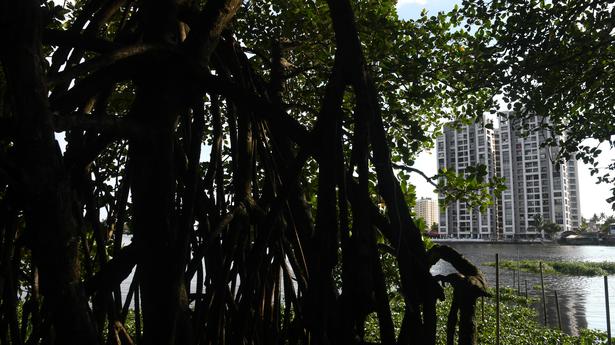
Mangroves
The Hindu
KOCHI
Will Kerala be devoid of its remaining mangrove vegetation that has been guarding the coast from the fury of nature besides delivering a host of ecosystem services?
The question reverberates in the minds of specialists in coastal ecology as well as conservationists even as the State government has approved a set of recommendations from a panel, which if implemented, would have a bearing on the mangrove ecosystem.
The mangrove vegetation that had once extensively lined the coastal belt of the State had provided the breeding ground for a large number of species of fish and shrimps. They have also been rendering the ecosystem a service by shielding the coastline from surges and waves, binding the coastal soil layers, and preventing soil erosion and withstanding floods. They also sequester carbon and thus play an important role in combating climate change.
It’s the proposal of the panel to set up a Mangrove Land Bank (MLB) where small and isolated patches of mangrove vegetation could be relocated that has triggered the debate.
The suggestion for MLB came from an expert committee on pre-draft coastal zone management plan 2019 under coastal regulation zone notification, 2019. The committee was constituted to examine the draft Coastal Management Plan for Kerala, which was prepared by the National Centre for Earth Sciences Studies, and rectify the deficiencies in the proposal. Besides the Additional Chief Secretary, Department of Environment, P.Z. Thomas, Managing Director, Environmental Engineers and Consultants Private Limited and P.B. Sahasranaman, a High Court lawyer, who had conducted several Coastal Regulation Zone-related cases, were the members of the panel.
In its report, the panel suggested that small patches of mangroves in CRZ- II or CRZ-III, which are of less than 50 sq m area may be considered to be relocated to a Mangrove Land Bank.
While relocating the plants, the owner of said mangrove land shall pay the Kerala government an amount to undertake “afforestation five times the same in the Mangrove Land Bank to be set up under supervision of the State Forest Department. This step of relocation of mangroves in a land bank will promote an integrated mangrove development area in low-lying areas. Such integrated approach will promote mangrove forests and associated flora and fauna, including fish,” the panel has suggested.













